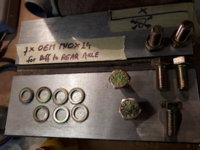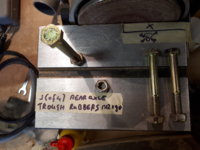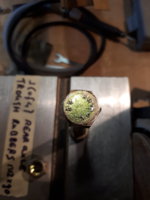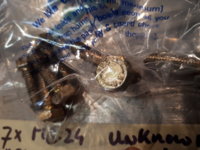I found this on a site for parachutists:
From p. 96, The Parachute Manual by Dan Poynter (2d edition, Parachute Publications, Santa Barbara, 1977):
"4.104 The Plating of Hardware
FAA Advisory circular 105-2: 5, b (8) reads; "PLATING OF FITTINGS. Plating or replating of load-carrying parachute fittings may cause hydrogen embrittlement and subsequent failure under stress unless the plating is done properly. Chrome or cadmium plated harness adjustment hardware may also have a smoother finish than the original and may permit slippage. The parachutist should be aware of these possible hazards."
All plating is not the same. The end result may appear similar but the strength of the finished product depends on the plating process used.
Most hardware is plated with cadmium to Federal Specification QQ-P-416, Type 1, Class 1,2, or 3. This is a fairly simple process whereby the piece is run through the plating bath and then "Baked." When replating with cadmium, the old plating must be removed and this must be done in a cyanide bath (rather than acid). Decorative plating, on the other hand is very attractive but difficult and tedious to do. The old plating must be stripped off. The metal must be buffed, copper plated, buffed again, nickel plated, buffed again, and chrome plated followed with a final buffing. All of this handiwork is very expensive and to further complicate the process, the hardware must be baked after each plating.
The plating bath is usually an acid solution and all acids contain hydrogen. The hydrogen enters the pores of the metal and rearranges the molecular structure rendering it brittle. hydrogen embrittlement is most apparent in spring parts because of their small cross section. Their resiliency is damaged by the hydrogen, not by any heat treating to which they have been subjected.
Magna fluxing (magnetic particle inspection) will not pick up hydrogen embrittlement and the plating will fill up any cracks which may have developed. The hydrogen does its damage and leaves so there is nothing to detect until the piece fails in use. Quality doesn't help either: the harder the steel, the more susceptible it is to hydrogen embrittlement.
BAKING. However, all is not lost. If the plated hardware is placed in an oven at 375 Fahrenheit degrees for a minimum of three hours WITHIN FIVE HOURS AFTER THE PLATING PROCESS, the hydrogen may be "Baked" out and the original strength of the metal may be retained. But take note: once this five hour period has passed, the damage is done. After this, no amount of baking will restore the hardware to a high percentage of its original strength.
Plating shops should be picked carefully. The "Junk chromers" who specialize in bumpers and other ornamental work are not concerned with strength and most do not have an oven; many are not even aware of hydrogen's damaging effects.
Parachute hardware may be properly chromed but it is so difficult and expensive that it rarely is. Because of the problems involved, cadmium plating is recommended. Good cadmium plating facilities with ovens may often be found on some large airports; use one which specializes in exacting aircraft work."
"4.104 The Plating of Hardware
FAA Advisory circular 105-2: 5, b (8) reads; "PLATING OF FITTINGS. Plating or replating of load-carrying parachute fittings may cause hydrogen embrittlement and subsequent failure under stress unless the plating is done properly. Chrome or cadmium plated harness adjustment hardware may also have a smoother finish than the original and may permit slippage. The parachutist should be aware of these possible hazards."
All plating is not the same. The end result may appear similar but the strength of the finished product depends on the plating process used.
Most hardware is plated with cadmium to Federal Specification QQ-P-416, Type 1, Class 1,2, or 3. This is a fairly simple process whereby the piece is run through the plating bath and then "Baked." When replating with cadmium, the old plating must be removed and this must be done in a cyanide bath (rather than acid). Decorative plating, on the other hand is very attractive but difficult and tedious to do. The old plating must be stripped off. The metal must be buffed, copper plated, buffed again, nickel plated, buffed again, and chrome plated followed with a final buffing. All of this handiwork is very expensive and to further complicate the process, the hardware must be baked after each plating.
The plating bath is usually an acid solution and all acids contain hydrogen. The hydrogen enters the pores of the metal and rearranges the molecular structure rendering it brittle. hydrogen embrittlement is most apparent in spring parts because of their small cross section. Their resiliency is damaged by the hydrogen, not by any heat treating to which they have been subjected.
Magna fluxing (magnetic particle inspection) will not pick up hydrogen embrittlement and the plating will fill up any cracks which may have developed. The hydrogen does its damage and leaves so there is nothing to detect until the piece fails in use. Quality doesn't help either: the harder the steel, the more susceptible it is to hydrogen embrittlement.
BAKING. However, all is not lost. If the plated hardware is placed in an oven at 375 Fahrenheit degrees for a minimum of three hours WITHIN FIVE HOURS AFTER THE PLATING PROCESS, the hydrogen may be "Baked" out and the original strength of the metal may be retained. But take note: once this five hour period has passed, the damage is done. After this, no amount of baking will restore the hardware to a high percentage of its original strength.
Plating shops should be picked carefully. The "Junk chromers" who specialize in bumpers and other ornamental work are not concerned with strength and most do not have an oven; many are not even aware of hydrogen's damaging effects.
Parachute hardware may be properly chromed but it is so difficult and expensive that it rarely is. Because of the problems involved, cadmium plating is recommended. Good cadmium plating facilities with ovens may often be found on some large airports; use one which specializes in exacting aircraft work."





